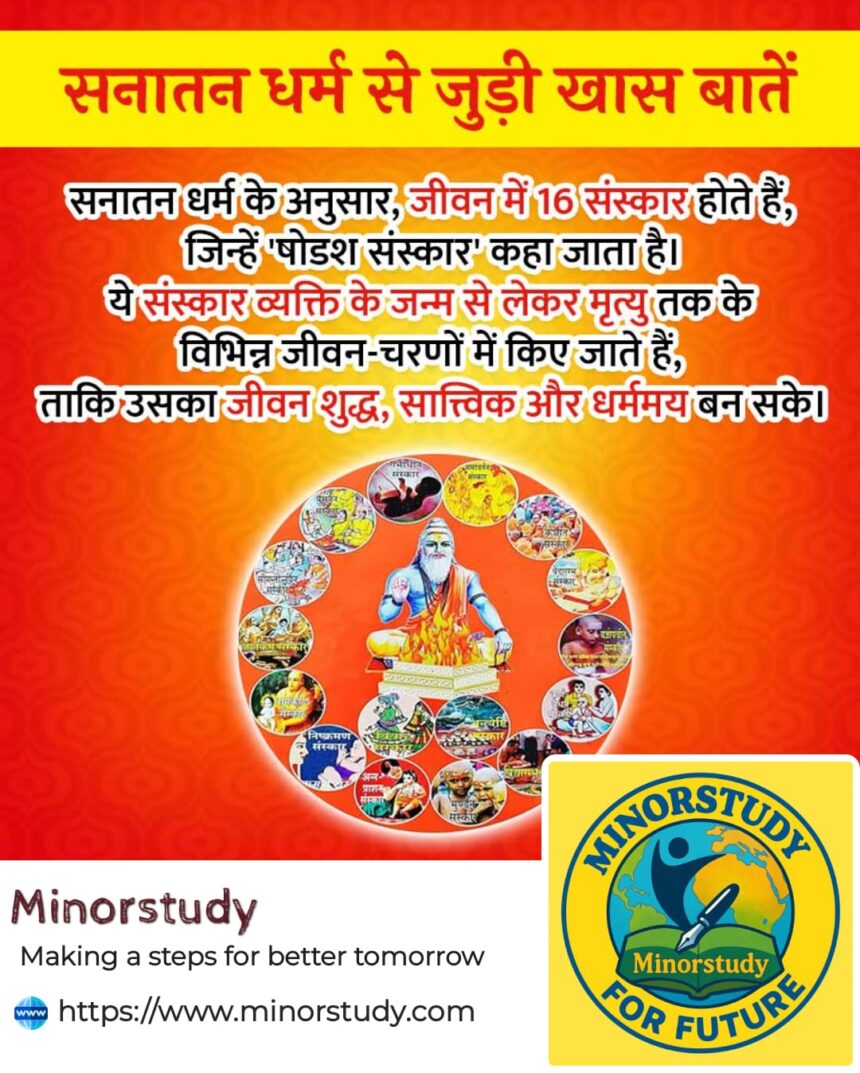16 Sacred Rites That Transform Life: The Powerful Truth of Sanatan Dharma’s Shodasha Sanskar
Shodasha Sanskar: Sanatan Dharma, also known as the eternal religion, is more than just a belief system—it is a way of life that spans across millennia. One of the most spiritually powerful and culturally rich contributions of Sanatan Dharma is the concept of the ‘Shodasha Sanskar’—the 16 samskaras or sacred rites that guide a person from birth to death, transforming their earthly journey into a path of purity, duty, and dharma.
- 📜 History of Shodasha Sanskar in Sanatan Dharma
- 🗓️ Timeline of the Shodasha Sanskar
- 🌟 16 Powerful Facts About Shodasha Sanskar
- ❓ FAQs About Shodasha Sanskar
- 🎯 Significance of Each Samskara in Human Life
- 🙌 Wishing Message for Observing Shodasha Sanskar
- 🌱 Importance of Shodasha Sanskar in Daily Life
- 📌 Important Points to Remember
- 🔍 Observance in Society Today
- 🧠 Conclusion: The Eternal Power of Sanatan Dharma’s Sanskar System
- 🌸 Final Reflection:
These 16 sanskars are not mere rituals but spiritual milestones designed to uplift a human being’s inner consciousness, connect them with cosmic energy, and establish harmony between the individual and society. Let’s explore everything you need to know about the Shodasha Sanskar—its history, significance, facts, impact on life, and its eternal relevance.
📜 History of Shodasha Sanskar in Sanatan Dharma
The concept of samskara (sacred rites) is deeply embedded in the Vedic tradition. The origin of these 16 samskaras is found in the Grhya Sutras, ancient Hindu texts that describe the domestic rites and rituals to be followed by a householder.
Great sages like Maharishi Manu, Yajnavalkya, and Parashara emphasized the necessity of samskaras in shaping the human character and soul. These rites were created not for mechanical practice but to align one’s life with dharma (righteousness), artha (purpose), kama (desires), and moksha (liberation).
Over centuries, these sacred rites evolved into social and spiritual ceremonies carried out in every Hindu household, forming the moral and spiritual bedrock of Sanatan Dharma.
🗓️ Timeline of the Shodasha Sanskar
| Life Stage | Samskar (Sacrament) | Purpose |
|---|---|---|
| Before birth | 1. Garbhadhana – Conception ritual | To conceive a virtuous child |
| 2. Pumsavana – Fetus protection | For the good health of fetus | |
| 3. Simantonnayana – Baby shower | Mental stability of mother | |
| Birth to infancy | 4. Jatakarma – Birth ceremony | Welcoming the soul to earth |
| 5. Namakarana – Naming ceremony | Assigning identity | |
| 6. Nishkramana – First outing | Introduction to outer world | |
| 7. Annaprashana – First solid food | Transition to external nourishment | |
| 8. Chudakarana – First hair cut | Removal of past karma | |
| Childhood | 9. Karnavedha – Ear piercing | Spiritual awakening |
| 10. Vidyarambha – Beginning education | Initiation into learning | |
| 11. Upanayana – Sacred thread ceremony | Entrance into Brahmacharya | |
| 12. Vedarambha – Beginning Vedic studies | Spiritual development | |
| Adolescence | 13. Samavartana – Completion of studies | Graduation |
| Adulthood | 14. Vivaha – Marriage | Entry into Grihastha Ashram |
| Later years | 15. Vanaprastha – Retirement | Detachment from worldly life |
| End of life | 16. Antyeshti – Final rites | Moksha & union with Brahman |
🌟 16 Powerful Facts About Shodasha Sanskar
Oldest Ritual System in the World
Covers All Stages of Life—from Womb to Tomb
Designed for Spiritual Evolution, Not Just Social Duty
Backed by Rigveda, Yajurveda, and Grhya Sutras
Gender-Neutral in Essence
Highly Symbolic—Each Rite Represents an Inner Transformation
Practiced Across Castes and Regions (with variations)
Earliest form of Child Psychology and Prenatal Science
Deeply Linked to Ayurveda and Yoga
Aims to Cleanse Mind, Body, and Soul
Includes Ecological Wisdom (e.g., feeding animals, planting trees)
Strengthens Family and Community Bonds
Teaches Karma and Dharma Practically
Promotes Moral Values Through Ceremonial Teaching
Universal Application in Human Life, Beyond Religion
Still Practiced in Modern Hindu Families Worldwide
❓ FAQs About Shodasha Sanskar
Q1: What does ‘Sanskar’ mean in Sanatan Dharma?
A: Sanskar means a refinement or purification process—rituals that uplift the individual spiritually and morally.
Q2: Are these 16 samskaras mandatory?
A: While traditionally considered essential, they are optional based on family traditions, beliefs, and regional practices.
Q3: Do women also undergo these samskaras?
A: Yes. Many of them, especially prenatal and educational samskaras, apply to girls and boys alike.
Q4: Is there any scientific relevance to these rites?
A: Yes, many rites like Annaprashana, Karnavedha, Chudakarana, etc. are medically and psychologically beneficial.
Q5: Are these rites relevant in the modern era?
A: Absolutely. They serve as cultural, spiritual, and moral compasses, especially in an age of increasing stress and disconnection.
🎯 Significance of Each Samskara in Human Life
Each sanskar has a deep psychological, emotional, and spiritual impact:
Garbhadhana ensures the couple is mentally and spiritually ready for conception.
Jatakarma welcomes the soul, symbolizing reincarnation and karmic entry.
Vidyarambha instills reverence toward learning.
Upanayana transforms the child into a seeker of knowledge (Brahmachari).
Vivaha binds two souls in sacred dharma-bound companionship.
Antyeshti completes the soul’s journey, liberating it from the physical form.
These rites stabilize the mind, strengthen the family, and anchor life to higher purposes.
🙌 Wishing Message for Observing Shodasha Sanskar
🟢 “May the divine journey of Shodasha Sanskar bless your family with purity, purpose, and peace. May each step bring your soul closer to dharma, knowledge, and moksha. Om Shanti!”
Observing these sanskars is like lighting 16 lamps of consciousness, illuminating one’s life path in every direction—material and spiritual.
🌱 Importance of Shodasha Sanskar in Daily Life
Teaches Respect for Elders and Nature
Encourages Clean Living and Mindfulness
Provides a Framework for Ethical Living
Builds Self-Discipline in Children
Celebrates Milestones with Family & Community
Connects Individual Karma with Cosmic Order
The Shodasha Sanskar gives structure and sanctity to every major life event, reminding us that life is sacred from start to end.
📌 Important Points to Remember
Shodasha = 16; Sanskar = Rituals of Refinement
Found in Vedic Scriptures, Grhya Sutras, Manusmriti
Aim: Spiritual elevation, moral discipline, social bonding
Each rite involves chanting of Vedic mantras, community participation, and symbolic gestures
Emphasis on self-realization, right conduct, and purification
🔍 Observance in Society Today
Many families still observe key samskaras like Naamkaran, Annaprashan, Upanayan, Vivah, and Antyeshti
Schools and Gurukuls revive Vidyarambha and Vedarambha on Saraswati Puja
Awareness campaigns by dharmic organizations emphasize their cultural necessity
Neo-Vedic movements globally bring renewed focus on sanskars for youth
🧠 Conclusion: The Eternal Power of Sanatan Dharma’s Sanskar System
In an age of fleeting trends and temporary beliefs, Sanatan Dharma stands timeless, rooted in eternal values and scientifically sound rituals. The Shodasha Sanskar is a sacred gift—an instruction manual for life that teaches us how to be born with purpose, live with meaning, and depart with dignity.
These rites aren’t just religious—they are psychological anchors, social glue, and spiritual ladders.
They guide us to:
Think with clarity,
Act with dharma,
Love with purity,
And die with peace.
🌸 Final Reflection:
🕉️ “To live a life enriched by Sanskars is to live not just for oneself, but for the cosmic harmony of all beings.”
🌺 May we all embrace these ancient yet ever-relevant samskaras and lead lives that are pure, purposeful, and peaceful.








